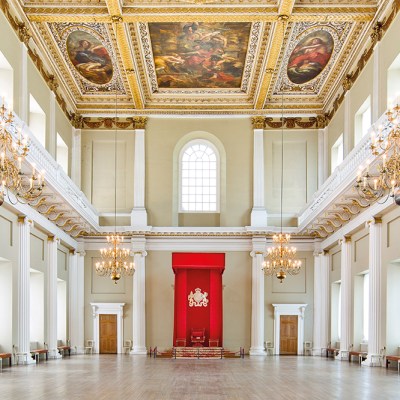This review of London’s ‘Golden Mile’: The Great Houses of the Strand, 1550–1650 by Manolo Guerci (Paul Mellon Centre) was published in the March 2022 issue of Apollo. Preview and subscribe here.
The Strand is one of London’s in-between zones, part of the West End but not at the centre of it. Today its chief function is to carry traffic from the City of Westminster to the City of London. It is a street that you are more likely to hurry along than linger on, and the noise, traffic and pollution mean that you do so with your head down. Yet it is also a place of continual change. The planned pedestrianisation of the area in front of King’s College and Somerset House will turn this stretch into a tranquil piazza. Perhaps future generations of Londoners will come to see the Strand as a place of repose rather than one of transit.
Around half a millennium ago, Londoners would have experienced the Strand in a completely different way. In those days, the Strand – the name refers to the fact that it was then on the bank of the river – was the location of London’s ‘palace district’, the home in town of many of the most powerful and influential aristocrats in the country. Their names form a roll call of some of the most important figures of the Tudor, Elizabethan and Jacobean courts: John of Gaunt, forefather of the Tudor dynasty, lived here; so too did the ‘Protector’ Lord Somerset, guardian and regent of the boy-king Edward VI. Elizabeth I’s chief ministers Lord Burghley and his son the Earl of Salisbury were later residents, as was the Earl of Arundel, tastemaker at the court of James I, and the notorious Duke of Buckingham, James’s favourite – and possibly even lover.
 In his meticulously researched and elegantly presented book on the subject, Manolo Guerci terms this area London’s ‘Golden Mile’. The epithet is apt, evoking as it does the stretch of Blackpool’s promenade where the highest concentration of its slot machines is to be found. One can almost imagine hearing a similar ker-ching when walking down early modern London’s very own stretch of promenade.
In his meticulously researched and elegantly presented book on the subject, Manolo Guerci terms this area London’s ‘Golden Mile’. The epithet is apt, evoking as it does the stretch of Blackpool’s promenade where the highest concentration of its slot machines is to be found. One can almost imagine hearing a similar ker-ching when walking down early modern London’s very own stretch of promenade.
But while country houses such as Burghley still stand as monuments to the wealth and power of England’s foremost statesmen, the great London mansions that were often their prototypes have been lost, buried beneath the Strand’s many transformations. Mostly, the street names are all that remains. If you turn off the Strand towards the river and find yourself on Arundel Street, Essex Street, Villiers Street or Northumberland Avenue, you are in fact walking in the grounds and along the frontages of some of these great palaces: Arundel House, Essex House, York House and Northumberland House.
Surviving examples are rare, but impressive. There is the York Watergate, now incongruously situated in the Victoria Embankment Gardens, a classical arch once thought to be the work of Inigo Jones but in fact by the mason and sculptor Nicholas Stone, which served as the entrance from the river to the Duke of Buckingham’s residence at York House. Although today’s Somerset House is the work of the 18th-century architect William Chambers – his masterpiece – you still get a sense of what was there before. There are Chambers’s architectural nods to Inigo Jones and John Webb’s work for one-time resident Queen Henrietta Maria, such as the composition of the main Strand-facing elevation which is inspired by the New Gallery, then thought to be by Jones but probably by Webb. And there is the vast footprint of the palace itself, a reminder of the fact that when Lord Somerset first had it built (in an Italianate style that had never before been seen in England) he was, in effect, king.
Nevertheless, though suggestive, these remnants still don’t do much to convey a sense of the sheer magnificence of these palaces. To do this, you need to travel outside London to, say, the Ashmolean Museum in Oxford. Here you can find the Arundel Marbles, a collection of classical statuary formed by Thomas Howard, 14th Earl of Arundel, in the early 17th century. When Arundel, inspired by his travels abroad, chose to display his collection in the gardens of his residence at Arundel House, he created the first Italian-style sculpture garden in England, evoking the example of Julius II in Rome. When you see them in the background of Daniel Mytens’s portrait of the earl, it is hard to believe that the river they stretch down to can be the Thames.
Indeed, magnificent though the Arundel Marbles may be, it is difficult to picture how they could ever have stood in surroundings that are now largely occupied by the dismal 180 The Strand. Hence the importance of Guerci’s book. In chapters that deal with each of the Strand palaces in turn, he lays out the surviving evidence of them with admirable clarity. Illustrations, maps, manuscripts and plans – both contemporary and as reconstructed by the author – are all marshalled to capture as vivid a sense as is possible of what has been lost, much of it before the age of photography. Taking us on a tour of these palaces when they were at their zenith, Guerci brings us closer to an age in which the Strand could be considered ‘an extension of Whitehall’, as he terms it.
The Strand palaces were truly unique. Unlike those of continental Europe, which dominated their urban environment, the palaces of the Golden Mile presented themselves to the river. As such, Guerci observes, they could be regarded as quintessentially English – a blend of outwardness and inwardness. Unlike their continental counterparts, however, they do not survive. Nevertheless, there is plenty of gold that lies buried just above the Embankment. We must hope that the author’s ambition to inspire more scholarship about these palaces will be fulfilled.
London’s ‘Golden Mile’: The Great Houses of the Strand, 1550–1650 by Manolo Guerci is published by the Paul Mellon Centre for Studies in British Art.
From the March 2022 issue of Apollo. Preview and subscribe here.



